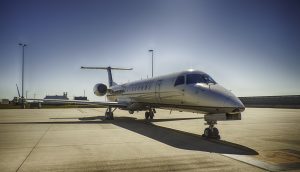Crain’s Cleveland Business
By Jay Miller

CommutAir had flown flights out of Cleveland for the former Continental Airlines, but Continental was merged into United Airlines and its flights from Hopkins ended when United trimmed its operation there in 2014.
Actually, there was no reason passengers waiting to board United Express flight 4889, the 2:50 p.m. flight leaving Hopkins that day, would have known they were boarding a CommutAir plane. The airplane they boarded for the 80-minute nonstop flight to Dulles International Airport in Reston, Va., outside Washington, D.C., even had the words “United Express” on the fuselage.
“The only time you know you’re not flying United is when we announce during our safety briefing, ‘Thank you for flying United Express operated by CommutAir,’ ” said Subodh Karnik, CommutAir’s president and CEO. “Everything we’re doing has to be almost seamless” with United.
Last September, the company announced it would move its corporate headquarters from Burlington, Vt., to North Olmsted and expand its administrative operations here. It said it would “consolidate offices, tap the local talent pool and benefit from the competitive costs facilitated by the state and city’s incentive programs.”
That statement was referring to two financial incentives — one from the state of Ohio and the other from the city of North Olmsted — the company won.
The Ohio Tax Credit Authority awarded a nine-year, 1.9% Job Creation Tax Credit that could be worth $1.1 million to CommutAir if it adds $6.7 million in new annual payroll to its $5.5 million in existing payroll in North Olmsted. The city of North Olmsted offered the airline a similar tax credit.
As a regional airline, CommutAir doesn’t market air travel or operate a reservation system. All it does is fly passengers and maintain smallish airplanes that mostly seat 50 passengers or fewer. It lets its partner, Chicago-based United Airlines, compete for passengers and manage their travel.
CommutAir’s flights generally cover 500 miles or less and bring passengers to United’s major hubs at Dulles and Newark Liberty International Airport in Newark, N.J. It handles 900 flights a week for United, flying from 34 airports. The number of flights is expected to grow as United, which has a 40% ownership interest in CommutAir, helps with the expansion.
The majority owner is Champlain Enterprises LLC, a privately held firm that has operated as a regional airline since 1989.
CommutAir came to the Cleveland area in 2007, bringing its operations center to North Olmsted when it began to operate flights as Continental Express, the identity Continental used for its regional carriers. When Continental’s busy hub operations ceased at Hopkins after its merger with United, CommutAir kept its operations center here, even though it no longer flew from Hopkins.
The North Olmsted office grew to 138 CommutAir employees before the headquarters move, operating the airline’s flight and system nerve centers, as well as its maintenance planning, crew scheduling, human resources and finance operations.
That number now has grown to 165, and the company has pledged to the tax credit authority that it will grow to 217 employees by the end of 2020. The company has 18,000 square feet of office space at Great Northern Corporate Center and is exploring additional space in its current location.
Overall, the company employs 900, many at a maintenance and training base in Albany, N.Y.
What will fuel that growth is CommutAir’s switch to a more sophisticated airplane and a plan to grow that fleet.
“In three years from now, we’ll be triple in size, and I’m assuming that trajectory will continue,” Karnik said.
What had been a fleet of 23 turboprops a few years ago has been converted to a similar number of Embraer ERJ145 jet aircraft. The plan, Karnik said, is to grow to 61 Embraer jets over the next three years. The company has a commitment from United to sublease those airplanes, he said.
CommutAir is one of nine regional airlines with relationships to United. Although their roles are expanding, the regionals fly routes between smaller cities that couldn’t fill larger aircraft to the busy hubs of the major airlines.
In a brief statement, a United Airlines spokesman said, “CommutAir is a valued partner and we look forward to continuing to work together to ensure we provide a great travel experience for our customers throughout our network.”
The mainline airlines, including American and Delta airlines, delegate those routes to regional carriers largely because of cost. The flight crews of major airlines are unionized, so they command a pay level that would make flying smaller planes with fewer passengers unprofitable.
Pilots and first officers on regional airlines are not unionized and earn considerably less. Working on a regional airline, though, is seen by pilots as a stepping stone to a job with a major airline. However, a recent shortage of flight crews is raising pay levels. CommutAir is offering a $22,100 sign-on bonus to attract new crew as it expands.
The major airlines increasingly rely on the regionals. In 2016, regional air carriers accounted for 51% of the departures from Hopkins, according to data compiled by the Regional Airline Association, though that represents only 28% of the passengers, because of their smaller airplanes.
Southwest Airlines, a major carrier at Cleveland Hopkins, has a different strategy and relies only on larger aircraft. The same is true of other low-cost carriers, which tend to fly high-volume routes.
William Swelbar, a longtime industry observer who is a research engineer at the International Center for Air Transportation at the Massachusetts Institute of Technology, believes Karnik’s, and United’s, strategy is sound.
“Of the three network carriers, United has made clear its intentions to grow its network by connecting more smaller markets to their existing hub structure,” he wrote in an email. “So there could not be a better partner (for CommutAir) in the immediate term.”
Swelbar wrote that while the United strategy is not embraced by Wall Street, he contended that smaller markets, where there is less competition among air carriers, generate a disproportionate share of revenue. So he views the growth of a captive regional like CommutAir “as a revenue positive story for the airline badly in need of a revenue story.”
While in the past he viewed CommutAir as “a marginal operator,” his opinion is changing.
“At the time, the airline was operating primarily turboprop aircraft with poor reliability,” Swelbar wrote. “As they transition to a primarily jet operation, I expect their operational metrics to improve. Moreover, I am sure that is being demanded of them by United as well.”
Robert Mann, president of R.W. Mann & Co., Port Washington, N.Y., an airline industry consultant, concurs with Swelbar’s assessment of the United-CommutAir strategy.
“The replacement of turboprops with jets is a ‘save the franchise from oblivion’ move, so Subodh (Karnik) would undoubtedly be pleased,” Mann wrote in an email. “Same transition is occurring for American wholly-owned Piedmont.”
Source:
Crain’s Cleveland Business







